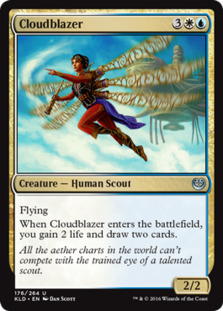Budget Magic: $98 (38 tix) Infinite Bantharmonicon (Standard)
Aang, Budget Magic lovers, it's that time again! A couple of weeks ago for Brewer's Minute, we talked about some crazy ways to go infinite with Felidar Guardian. So, this week for Budget Magic, we are going to put these ideas into practice with a deck that can make infinite mana, draw an infinite number of cards, gain infinite life, and deal infinite damage, all in Aether Revolt Standard! We also get Panharmonicon and a bunch of sweet value creatures, so when we are not comboing off, we can win the game by doubling up all of our enters-the-battlefield triggers and drowning our opponent in card advantage! Combine these two things together and you have Infinite Bantharmonicon!
We'll talk more about Infinite Bantharmonicon after the videos, but first a quick reminder: if you enjoy the Budget Magic series and the other video content on MTGGoldfish, make sure to subscribe to the MTGGoldfish YouTube Channel to keep up on all of the latest and greatest.
Infinite Bantharmonicon: Deck Tech
Infinite Bantharmonicon vs. GR Energy
Infinite Bantharmonicon vs. Jeskai Saheeli
Infinite Bantharmonicon vs. GB Constrictor
Infinite Bantharmonicon vs. Paradoxical Outcome
Infinite Bantharmonicon vs. RB Aggro

The Deck
Probably the easiest way to break down the deck is to go step-by-step through our infinite combos to see what we are trying to set up, and then we'll talk about the other filler cards at the end. Let's start with the cards that make all of our different combos possible with their blink abilities: Felidar Guardian and Wispweaver Angel.


Felidar Guardian is the card that makes Infinite Bantharmonicon work. In fact, it's so important that we are also playing a couple copies of Wispweaver Angel as a six-mana backup Felidar Guardian. The basic idea of the deck is that we get two of our Felidar Guardians on the battlefield at the same time (for the rest of the article, when I talk about having two Felidar Guardians, just assume you can substitute Wispweaver Angel for one of them). With two Felidar Guardians on the battlefield, we have infinite blink triggers (with Felidar Guardian blinking the other Felidar Guardian an infinite number of times). In our deck, just having infinite enters / leaves the battlefield doesn't do very much (although we do have a copy of Pious Evangel to gain us infinite life, just in case), but things really get out of control when we add a third card to the mix.
![]()
With a Panharmonicon on the battlefield, Felidar Guardian and Wispweaver Angel are pretty insane on their own, blinking two of our value creatures to draw more cards or gain more life, but when we get two Felidar Guardians on the battlefield, things get really out of control. Each time a Felidar Guardian enters the battlefield, we get two "blink" triggers. We use the first one to target the other Felidar Guardian (allowing us to repeat the process an infinite number of times) and the second targeting something else. For example...

Targeting a land with our second blink trigger allows us to generate infinite mana because every time we got through the blink loop, the land comes into play untapped. As such, we can tap the land in between, floating a mana, so after going through the loop a large number of times (for example, 1,000) we'll have a large number of mana (also 1,000). Once we have all the mana we can possibly use (actually, in our deck, usually somewhere around 50 is usually enough, although it does vary a bit based on the situation), we turn our second blink trigger to drawing cards.




This group of cards is great in almost every situation. Before we have any combo pieces, cards like Thraben Inspector and Rogue Refiner help us cycle through our deck to find combo pieces while also giving us blockers to stay alive. Once we have a Panharmonicon on the battlefield and all of their enters-the-battlefield triggers are doubled, we can sometimes win without the combo by drowning our opponent in a steady stream of life gain and card advantage from Cloudblazer and Prophetic Prism. Finally, once we go into the infinite blink loop and make all of the mana we'll ever need by blinking a land a bunch of times, we turn our second blink trigger on one of our 16 card-draw permanents, which allow us to draw our entire deck!

So, we make infinite mana and draw our entire deck. The last step of our combo is to have a way to win the game, and for this, we have a single copy of Walking Ballista (we would play more, but the Aether Revolt rare is really expensive, which makes it hard to fit multiple copies under the budget). Thankfully, to win the game, we only need a single copy because we use our infinite mana to cast Walking Ballista with X greater than our opponent's life total; then, we simply ping our opponent to death one life point at a time by removing counters!
Other (Non-Combo) Stuff

Eldritch Evolution walks the line between being a combo piece and a good value card. While the main reason it is in our deck is to tutor up copies of Felidar Guardian and Wispweaver Angel to start the infinite blink combo, it's also fine when it is tutoring up cards like Cloudblazer (especially when we have a Panharmonicon on the battlefield).

Servant of the Conduit helps speed everything up, allowing us to play four-drops like Felidar Guardian and Panharmonicon on Turn 3 rather than on Turn 4. It's also just a fine on-curve two-drop, which makes it a great fit in our deck.

Pious Evangel is only a one-of, but it allows us to go infinite in life, even without a Panharmonicon (with the help of the infinite blink loop making a ton of "enters the battlefield" triggers). While infinite life by itself is often enough to get an opponent to scoop up the game (less so on Magic Online, because we can't really gain infinite life thanks to the amount of clicking it takes to go through the loop), at the very least, it usually buys us enough time to set up the game-ending infinite mana / card draw / damage combo.

We have more removal in the sideboard when the matchup calls for it, but in the main deck, we go with a couple of copies of Stasis Snare, since it is the least conditional instant-speed removal spell in our colors. Since we don't have many "removal" slots in the deck, we want a card that can deal with not only the Copy Cat combo but also vehicles like Heart of Kiran, big creatures with GB Constrictor, and any random Eldrazi that might show up, and Stasis Snare fits the bill.
A Word on Magic Online
As you could probably see in the videos, the infinite combos are a bit clunky on Magic Online, since there isn't really a good way to shortcut. This means that going through the infinite blink combo requires quite a bit of clicking (although it helps if you set your auto-yields to "always yes"). This is one of the reasons we aren't more all-in on the Pious Evangel infinite life combo. While in paper you can just demonstrate the loop and gain 1,000,000 life in a matter of seconds, on Magic Online, you have to go through the loop every single time, which means that gaining more that 50 or 100 life (large but not game-ending amounts) is difficult.
That said, I played the deck on Magic Online for the videos, hardly any opponents actually scooped to the infinite combo, and I never came especially close to timing out, so it is certainly playable online; it's just important to pull off the combo as efficiently as possible, so here are some numbers and tips.
- When you have the double "blink" triggers, always click the second Felidar Guardian first (so that trigger resolves last). It's easy to zone out after a while and just start clicking, but this is the order you need to take full advantage of the blinking power. The good news is that the combo is very forgiving, in the sense that as long as you blink the Felidar Guardian with any one of the triggers, you get another shot at doing it right.
- Typically, we need 40 mana to win (assuming our opponent is at 20 life) with Walking Ballista, but I usually try to make a couple of extra mana, just in case.
- Once you start the infinite draw combo, make sure to not draw yourself to death (this is especially problematic with Cloudblazer and multiple Panharmonicons, since you draw big chunks of cards and the triggers are not "mays"). As soon as you find the Walking Ballista, you can stop drawing.
- If something goes horribly wrong mid-combo, you can always restart the process by casting another "blink" creature or an Eldritch Evolution to find one and start making mana / drawing cards all over again.
- If you can, find two Felidar Guardians because the combo will be a lot quicker. With two Felidar Guardians, we are making a mana with every blink loop. If we replace a Felidar Guardian with Wispweaver Angel, we are only untapping a land every other blink loop because Wispweaver Angel can't untap a land.
- Finally, especially once your opponent realizes what's happening, there's nothing wrong with telling them how the combo works (you're going to have to reveal this information anyway) if it will help get them to scoop. Some players will make you play it out no matter what, but a decent number of players would rather move on to game two and start playing more Magic rather than sit there and watch you go through an infinite loop a whole bunch of times.

The biggest change to the ultra-budget build is that we lose Walking Ballista as our combo finish and replace it with Burn from Within. The good news is that winning with Burn from Within is even easier on Magic Online, because it only takes half the mana that Walking Ballista does, but the downside is that it gets countered by Negate and will likely be uncastable when we aren't comboing off (after we combo off and draw our entire deck, we'll find a Prophetic Prism to make the mana we need to cast it). Otherwise, we trim back on some of the most expensive cards, such as by dropping down to three Panharmonicons, and make the mana base even cheaper with the help of Evolving Wilds over some duals, but otherwise, the list should play exactly the same as the one in the videos.

Non-budget Infinite Bantharmonicon gets three big additions. First, it gets the full four copies of Walking Ballista, which does two things. For one thing, it's just a really strong Magic card and is good in most matchups. Also, it helps cut down on the number of clicks needed to combo off on Magic Online (since we'll draw a copy more quickly). The second addition is Verdurous Gearhulk, which gives us an even better backup plan when we aren't winning with the combo, since we can simply double or triple up the trigger with Panharmonicon and beat down (putting a ton of counters on Walking Ballista is also pretty sweet). Finally, we get a non-budget mana base, which should help everything run a bit smoother. All in all, the non-budget build is a significant upgrade, but in many matches (where we win with the combo), the changes won't really do anything. Also, if you are working on the upgrade, feel free to throw in any extra copies of Walking Ballista and Verdurous Gearhulk you happen to have sitting around—you don't need the full four to make the upgrade worthwhile.
Conclusion
Anyway, that's all for today. We ended up going 3-2 in our video matches and 4-3 overall (with an extra win against UB Control and a loss against an aggro list), and the deck felt really good. The combo is pretty unbeatable, and we didn't really have a problem with opponents fizzling it with removal, and even without comboing, our deck does a good job of staying alive by making a bunch of blockers and drawing a bunch of cards. Plus, like last week's Paradoxical Outcome deck, Infinite Bantharmonicon is a great deck for getting a response from opponents, who either think it's amazing or get upset that they have to sit there for 10 minutes while we blink our own Felidar Guardians. Give it a shot—I don't think you'll be disappointed!
As always, leave your thoughts, ideas, opinions, and suggestions in the comments, and you can reach me on Twitter @SaffronOlive or at SaffronOlive@MTGGoldfish.com.













